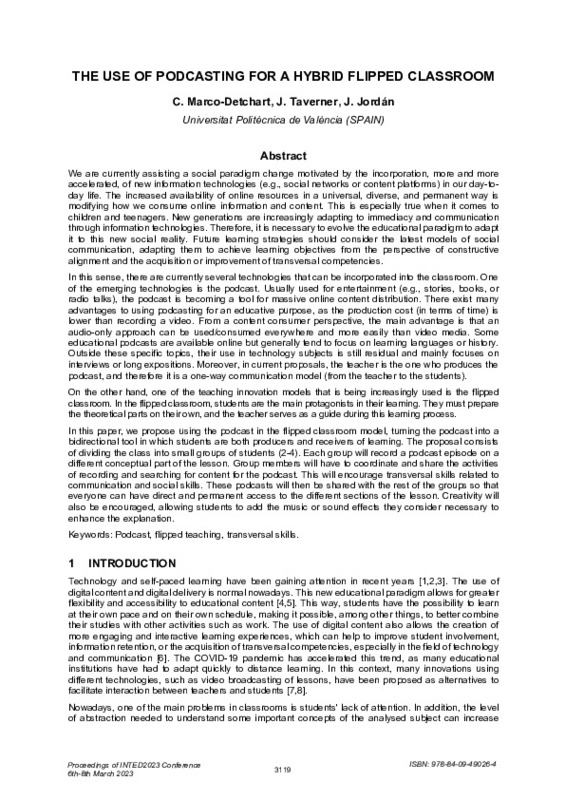|
Resumen:
|
[EN] We are currently assisting a social paradigm change motivated by the incorporation, more and more
accelerated, of new information technologies (e.g., social networks or content platforms) in our day-today life. The ...[+]
[EN] We are currently assisting a social paradigm change motivated by the incorporation, more and more
accelerated, of new information technologies (e.g., social networks or content platforms) in our day-today life. The increased availability of online resources in a universal, diverse, and permanent way is
modifying how we consume online information and content. This is especially true when it comes to
children and teenagers. New generations are increasingly adapting to immediacy and communication
through information technologies. Therefore, it is necessary to evolve the educational paradigm to adapt
it to this new social reality. Future learning strategies should consider the latest models of social
communication, adapting them to achieve learning objectives from the perspective of constructive
alignment and the acquisition or improvement of transversal competencies.
In this sense, there are currently several technologies that can be incorporated into the classroom. One
of the emerging technologies is the podcast. Usually used for entertainment (e.g., stories, books, or
radio talks), the podcast is becoming a tool for massive online content distribution. There exist many
advantages to using podcasting for an educative purpose, as the production cost (in terms of time) is
lower than recording a video. From a content consumer perspective, the main advantage is that an
audio-only approach can be used/consumed everywhere and more easily than video media. Some
educational podcasts are available online but generally tend to focus on learning languages or history.
Outside these specific topics, their use in technology subjects is still residual and mainly focuses on
interviews or long expositions. Moreover, in current proposals, the teacher is the one who produces the
podcast, and therefore it is a one-way communication model (from the teacher to the students).
On the other hand, one of the teaching innovation models that is being increasingly used is the flipped
classroom. In the flipped classroom, students are the main protagonists in their learning. They must prepare
the theoretical parts on their own, and the teacher serves as a guide during this learning process.
In this paper, we propose using the podcast in the flipped classroom model, turning the podcast into a
bidirectional tool in which students are both producers and receivers of learning. The proposal consists
of dividing the class into small groups of students (2-4). Each group will record a podcast episode on a
different conceptual part of the lesson. Group members will have to coordinate and share the activities
of recording and searching for content for the podcast. This will encourage transversal skills related to
communication and social skills. These podcasts will then be shared with the rest of the groups so that
everyone can have direct and permanent access to the different sections of the lesson. Creativity will
also be encouraged, allowing students to add the music or sound effects they consider necessary to
enhance the explanation.
[-]
|
|
Agradecimientos:
|
The authors gratefully acknowledge the financial support of Consellería d'Innovació, Universitats,
Ciencia i Societat Digital from Comunitat Valenciana and the European Social Fund (Investing In Your
Future) (APOSTD/2021/227 ...[+]
The authors gratefully acknowledge the financial support of Consellería d'Innovació, Universitats,
Ciencia i Societat Digital from Comunitat Valenciana and the European Social Fund (Investing In Your
Future) (APOSTD/2021/227 and CIPROM/2021/077), the Spanish Ministry of Science (project
PID2021-123673OB-C31) and the Research Services of Universitat Politècnica de València. Jaume
Jordán is supported by grant IJC2020-045683-I funded by MCIN/AEI/10.13039/501100011033 and by
"European Union NextGenerationEU/PRTR".
[-]
|









